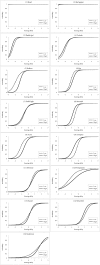Effects of Education on Differential Item Functioning on the 15-Item Modified Korean Version of the Boston Naming Test
- PMID: 28326109
- PMCID: PMC5355009
- DOI: 10.4306/pi.2017.14.2.126
Effects of Education on Differential Item Functioning on the 15-Item Modified Korean Version of the Boston Naming Test
Abstract
Objective: Education is expected to have an effect on differential item functioning (DIF) on the 15-item Modified Boston Naming Test in the Korean version of the Consortium to Establish a Registry for Alzheimer's Disease Assessment Packet (BNT-KC). However, no study has examined DIF in the BNT-KC.
Methods: We used the item response theory to investigate the impact of education on the DIF in the BNT-KC among elderly individuals with or without dementia (n=720). A two-parameter item response model was used to determine the difficulty and discrimination parameters of each item. The Benjamini-Hochberg procedure was used to address the risk of Type I errors on multiple testing.
Results: Four items, "mermaid," "acorn," "compass," and "pomegranate" continued to demonstrate DIF after controlling for multiple comparisons. Those with low education levels were more likely to error on "mermaid" and "compass," while those with high education levels were more likely to error on "acorn" and "pomegranate." "Hand" and "red pepper" were too easily identified to be used for detecting dementia patients. "Monk's hat" and "pomegranate" were less discriminating than other items, limiting their usefulness in clinical setting.
Conclusion: These findings may provide useful information for the development of a revised version of the BNT-KC to help clinicians make diagnostic decisions more accurately.
Keywords: Dementia; Diagnostic errors; Education; Language tests.
Figures


References
-
- Kaplan E, Goodglass H, Weintraub S. The Boston Naming Test. Philadelphia: Lea & Febiger; 1983.
-
- American Psychiatric Association. Diagnostic and Statistical Manual of Mental Disorders. Washington (DC): American Psychiatric Press; 1994.
-
- Jacobs DM, Sano M, Dooneief G, Marder K, Bell KL, Stern Y. Neuropsychological detection and characterization of preclinical Alzheimer's disease. Neurology. 1995;45:957–962. - PubMed
-
- Knesevich JW, LaBarge E, Edwards D. Predictive value of the Boston Naming Test in mild senile dementia of the Alzheimer type. Psychiatry Res. 1986;19:155–161. - PubMed
-
- Kittner SJ, White LR, Farmer ME, Wolz M, Kaplan E, Moes E, et al. Methodological issues in screening for dementia: the problem of education adjustment. J Chronic Dis. 1986;39:163–170. - PubMed
LinkOut - more resources
Full Text Sources
Other Literature Sources

